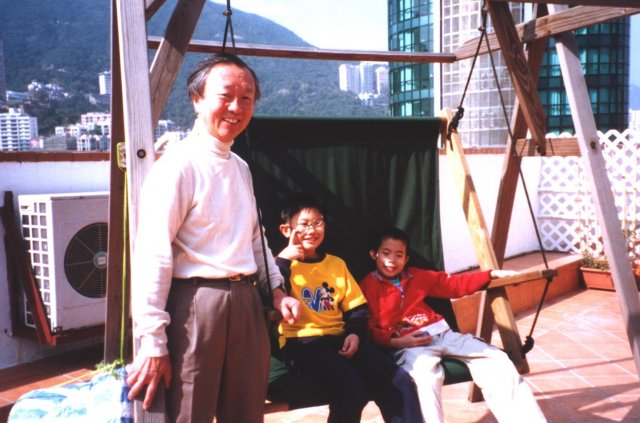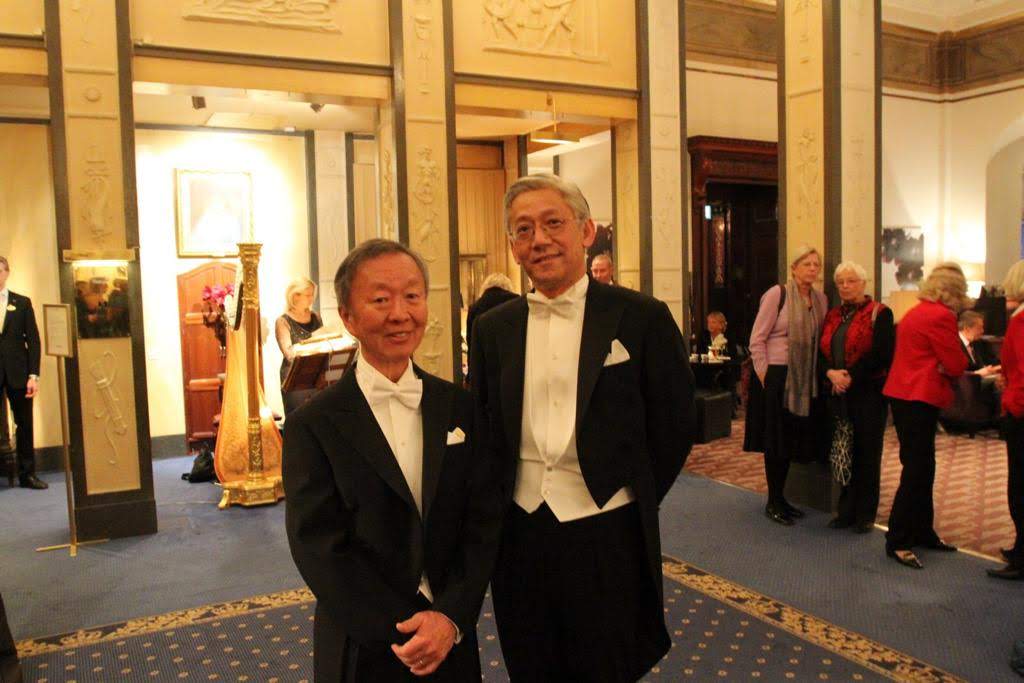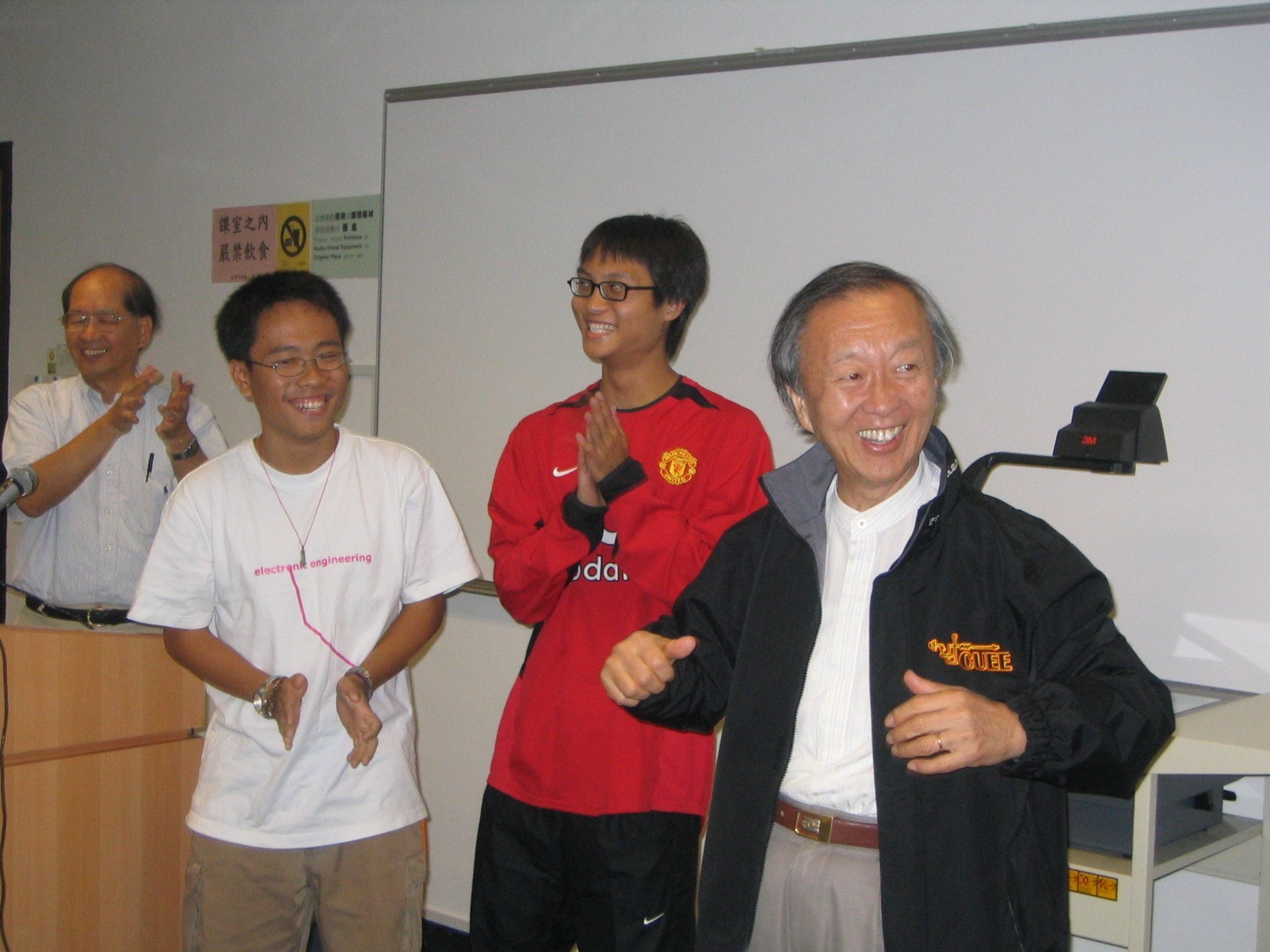Charles Kao was special to me. He gave me an opportunity to help establish an engineering faculty at CUHK. With his guidance, encouragement and support, I was able to recruit some best people in their fields to join CUHK. Many came because of Charles. The faculty now ranks among the best engineering schools.
Volumes have been written to honor him for his contributions to fiber optics and optical communication, which has made possible the internet revolution that has so dramatically benefitted humankind. I shall not repeat them here, except to say that I read one of his original papers in which he showed how the index of refraction should be varied in a fiber so to concentrate the light beam to minimize propagation loss. When I read it I was convinced that Charles would soon be recognized as a great scientist, and he was, many times, world-wide, culminating in the Nobel Prize in 2009.
Not to be overlooked was his contribution to education in Hong Kong. Prior to 1991, under the colonial rule, young people had very few opportunities to study engineering in Hong Kong. Charles initiated an electronics program at CUHK in 1970 and set up the Faculty of Engineering in 1991. Now aspiring engineers can obtain a university education second to none.
Charles was a gentle person, always polite to everyone, regardless his/her social station, friend or foe. He never wanted to harm anyone, always looked for the best in people. This trait marks a great man that he was.
We shall miss him, for his vision, wisdom and kindness.
Prof. Omar Wing
Founding Dean of Engineering (1991-1997), CUHK
Professor Sir Charles Kao, you will be truly missed in our hearts for your scholarship in optical fiber and leadership in CUHK. You have connected our world and made our life much better for all human beings. You will be dearly missed by all. My heartfelt condolences to you and your family.
Prof. C. P. Wong
Regents’ Professor & Smithgall Institute Endowed Chair,
Georgia Institute of Technology
Former Dean of Engineering (2010-2018), CUHK
高錕的遠見
許多年前,我曾在香港介紹高錕校長作學術演講。演講前我問他:「您在1966年發明光學纖維技術時,採用的玻璃導管究竟有多長?」高校長用手表示,只有三英尺左右。
由於傳導材料的改進、淨化,接駁技術的發明、普及,這三英尺現在已拉長到足以環繞地球,成為遠程資訊溝通的主要方式了。在2009年,高校長也榮獲世人欽羡的諾貝爾物理學獎表揚「在纖維中傳送光以達成光學通訊的開拓成就(for groundbreaking achievements concerning the transmission of light in fibers for optical communication)」。
我們今天紀念高校長的光輝一生,不會忘記他發明光學纖維技術時的遠見。
香港中文大學計算機科學與工程學系榮休教授
陳天機
We have lost a very dear colleague and a faithful leader.
Charles Kao embodied two values that have left an indelible mark on the Chinese University of Hong Kong: independent thinking; and a commitment to promote scientific research. I’ll never forget what he said when I asked him why he still believed in fiber optic communications while most experts considered it is inconceivable: “No one ever proved it is impossible.” That is why he brought so much largeness of heart when he was the Vice-Chancellor of CUHK.
What a great man and he will sure be missed. He is a very special person in my heart. Not only was it enlightening to have conversations with him, but I've never met a more educated scholar. His death, though tragic, will not be in vain. And he has a great reward in heaven!
My sincere condolences,
Prof. Tony Lee
Emeritus Professor, Department of Information Engineering, CUHK
Charles was an idol, a mentor, and a friend to me. I probably would not have worked on “optical communication networks” for my PhD thesis were it not for the pioneering work of Charles. I would not have landed in HK, working in CUHK, were it not for the fact that Charles visited Bellcore, my previous employer, every summer in the early nineties. I most definitely would not have taken the many paths I had taken in CUHK over the years were it not for the encouragement and inspiration from Charles.

I found in my computer a photograph taken in 1999. The occasion was probably my family and Frank Tong’s family visiting Charles and Gwen during the Chinese New Year. Charles was showing a few hand tricks that rely on physical laws to my two kids who had no idea who Charles was. They were playing all sorts of irreverent and impolite pranks on Charles and Gwen, who just took it as good fun -- the very human and kind side of Charles and Gwen.
Prof. Liew Soung-Chang,
Professor and Division Head,
Department of Information Engineering,
and Co-Director, Institute of Network Coding, CUHK
Professor Kao indeed among the most influential people in our Faculty of Engineering at CUHK. I was greatly indebted by Professor Kao for his futuristic vision in the internet and information technology. When he served as the Vice-Chancellor of CUHK, he founded our Faculty of Engineering as well as our Department of Information Engineering (IE) at CUHK. I was fortunate to be the first batch of undergraduate students admitted to the new Faculty under the 4-year Integrative Engineering Programme and I enrolled in the IE Programme in my second year of study. This brought me to the new world of fascinating information age, and made me acquaint the evolution of the modern telecommunication and networking technologies. I have also carried out research in optical fiber communications in my Ph.D. study. Prof. Kao’s contributions in optical fiber communications really enable the nowadays’ 4G/5G mobile systems, cloud computing, ultrahigh capacity long-haul optical fiber systems as well as internet of things, which greatly enhance the well-being of people. I would remember him and learn from his excellent scholarship & leadership.
My deepest condolences to Professor Kao’s family.
Prof. Calvin C.K. Chan,
Chairman, Department of Information Engineering, CUHK
It is difficult for a photonics physicist or telecommunication engineer, like myself, not comprehending the greatest contributions in the field of fibre optics by Prof. Charles Kao. I first came to meet Charles in person at an annual photonics conference in US. He presented himself as a fatherly figure, not only appealing to the scientists, engineers, and business people alike, he was particularly adored by Chinese photonics community. Between 1992 to 1995, I had opportunities of meeting Charles privately when he visited East Coast every summer where I was a research staff member at IBM Yorktown Heights. Over these occasions, we had discussions on the possibility of me joining CUHK. In the beginning of 1996, I took up the teaching duties in the Information Engineering Department. That was the most pivotal and important decision I have made for me and my family in my adult life, and Charles was the key figure in making this happened.
Before Charles retirement in 1996, I was a frequent visitor to the Vice Chancellor’s office. We spoke of many opportunities and challenges on fibre optics in China. Both photonics and educating the younger generations were definitely dear to his heart. Through Charles, I met many people who were influential in the field of science in Mainland. I also recalled a particular event we travelled together to Japan when he was to receive the distinguished Japan Prize from the Emperor and I was to attend meetings and conference. Gwen was there with us. The receptions at Sumitomo and other research institutes we visited were amazing. We had long rows of uniformed personnel greeting us before entering and leaving the compounds. There were many fanfares in 1996 when he retired from the Vice-Chancellor’s office. The Chinese Academy of Science had named a small planet after him. We had an occasion afterwards to talk about these events. I remembered he told me his departure unpredictably created a Big Bang. At that time, he was unaware of a bigger ceremonial event to come 13 years later.
Charles’ retiring life was not really retiring. He picked up an executive consultancy role at the Hong Kong Telecom. He has also led a couple of research and consultancy projects involving me and Soung Liew on investigating the social impacts of future internet. We worked intensely for weeks and we were convinced that this is going to be the next big thing in Hong Kong. Charles was very generous to us on compensation, even though he did most of the ideation. Over that two-year period, Charles and Gwen moved to a house at the top of Mount Austin. Literally, this is the highest point of the Victoria Peak, overlooking the entire Hong Kong harbour within a short walk from his residence. We had many memorable family gatherings. I remembered fireworks watching were particularly interesting from his place. Instead of looking up, we have to look down at the harbour. Everything seemed so unreal.
A few years before the bursting of optical and internet bubble, I was hotly demanded by various telecommunication companies and the one consumed most of my outside practice time was the executive advisory role at AT&T Bell Labs. Charles was busy preparing his new venture Transtech on optical fibre in TaiPo. We had some gatherings but were fewer than before. With the launching of the company, Charles was basically absorbed into the company. Albert Wong, who was a close colleague at Bell Labs, joined Transtech as the COO. In the summer of 2000, I decided to take up the secondment from CUHK and joined ASTRI as the head of the photonics group. Charles was kind enough to serve as our advisor. He came visiting us several times when we were at the original Tsim Sha Tsui site. Each and every one of his visits, the room was packed with researchers, trying to get his thoughts on their various ideas. Our researchers were definitely mobilised by the giant. It was really fun.
I remembered after the ASTRI’s spin-off in 2004, we always visited his new apartment in Happy Valley. He has scaled back substantially on his busy lifestyle and picked up mahjong and other leisurely habits. He was always in the happy mood. Then one day I was informed that Charles was diagnosed with dementia, the same disease his father had for a long period before he passed away. I was deeply saddened. Shortly afterwards, Gwen decided to sell off their apartment and moved to their condo in Mountain View. I had helped some of their moving, including bringing along boxes of belongings in my frequent trips to the Bay Area. I had frequent visits to his apartment in Bay Area, and have brought along my family and friends to see Charles. Charles was happy to see us. I called Gwen frequently to understand Charles conditions. In early 2009, Gwen told me Charles was awarded a Nobel prize and asked me if I have any interest to attend the week-long ceremony. I immediately accepted the invitation. I believed this was the closest thing to the Nobel event in my life. That was beautifully done, and the world celebrated the contributions by Charles. As a Chinese scientist by training, I never felt so proud. Charles conditions gradually deteriorated since then.
I never had the opportunity of working with Charles on scientific and technology inventions. When I entered the field, the optical fibre was already a marvellous success. I wonder the world would be like if optical fiber was not invented on time. There will be delays in the introduction of the internet, WiFi and 4G/5G, big data, and the list goes on and on. We will not be able to enjoy the conveniences and efficiencies we take for granted in our daily life.
Over these years of interactions, I see the genius in him. While many others may complain about the random nature in his thinking process, I saw the cognitive engine cylinders firing in all directions, connecting all dots that we were unaware of at lightning speed. He was both creative yet details, kind yet firm, and generous yet persistent. I believed his donation of the Nobel award to the good cause of education will have immense impacts for generations to come.
I looked at the piece of fine ceramic created by him which was given to me years ago and tried to relate to the creator of this artwork who happened to be the father of fiber optics. I have seen displays about Charles’ work at the STL R&D labs in Harlow, and have seen his life-size pictures and displays of his achievements at the science museum in London. It happened a couple of weeks ago before he passed away I decided to pay a visit to Charles’ alma mater University College London where he studied. I was wondering how any country, in particular, ours, can duplicate the spirit and environment for the growth of our next explorers in technology, as in discoveries of new continents in the past. There is little doubt that the next dimension of disruption and economic growth will be in innovation and technology. Charles has played the role of forefather in the field of telecommunication and internet. We will stand on the shoulder of this giant and take this forward. His legacy will live on.
Prof. Tong Fuk-Kay, Frank,
Adjunct Professor, Department of Information Engineering
and Global Head of Innovation and Strategic Investments of HSBC

While there are many brilliant inventions in engineering, seldom do we find one that has no alternative. Optical fiber is one such invention. Prof. Kao asserted that there would be no alternative for optical fiber in 1000 years, but he added that one should not believe in experts, because he had not either.
We used to see Prof. Kao having lunch by himself at the Franklin Student Canteen from time to time. It had been our privilege and honor to be close to this extraordinary yet ordinary person. Charles, we all owe you a lot.
Prof. Yeung Wai-Ho, Raymond,
Choh-Ming Li Professor of Information Engineering and Co-Director, Institute of Network Coding, CUHK
9月23日,幾乎是同時收到CUHK來的二個email,IE的Calvin Chan(陳俊傑)和 EE的JB Xu (許建斌)兩位教授,都即時告知高錕教授已經去世了,“Prof. Charles Kao has just passed away”……
消息傳來,使我甚是感傷,心情也十分錯综複雜,我跟我太太說,”環環,高錕走了,趕快給 Gwen寫個 email 吧。”
我就回想起在香港中文大學的那些日子,也不知道為什麼,突然想用中文來寫一點紀念高錕校長的文章,雖然我在中大上課時是全部用英文的。
1974-1980 年代我在美國新澤西州貝爾實驗室(Bell Labs, Holmdel,NJ) 在作非缐性光纖特性硏究時,參加了早期在美國及歐洲的光纖通信會議,在會場中就認識了我們尊敬的高錕先生。當時光纖通信技術因為1966年高先生在英國STL的創新成果,以及康寧玻璃公司首次做成功的低損耗氧化矽玻璃光纖,有很令人嚮往的高速寬頻光通信的遠景,激勵了全世界各大公司硏究部門都競相大幅投入資源作硏發,因此早期的光纖通信會議成長極為迅速。在這些國際光纖通信會議中,高錕先生若是在塲,總是成為最受歡迎的人,人人都希望和他打招呼並談談。因為高先生在此為創始者,他又交遊廣闊,相知的友人很多,在這些歐美的國際光纖通信會議上,當時還很年輕的他是眾人心目中的”開創英雄”人物,會塲上都有不少同行朋友見面找他寒暄,可以說是「左右逢源」。當時高先生都是顯得很開心,溫文爾雅,平易近人,是令人尊重的年輕才俊。
後來1983-1986 年高錕先生在美國的ITT Advanced Technology Center (Shelton, Connecticut)擔任首席科學家時,曾邀請我和太太去他的硏究中心參觀,並且安排我去訪問耶魯大學(Yale University) , 因為他在ITT ATC 當時有一個創新的Terabits/sec Project,和耶魯大學及麻省理工學院(MIT)有合作的項目。後來聽說高先生曾用他國際大獎的獎金一大部分捐给耶魯大學。當時高先生和夫人黃美芸(Gwen)就住在附近,所以我們也被邀請到他們在Shelton, Connecticut 的郊區的家,是個大房子,大院子,藍天綠地,大家一起聊聊,談天說地,很愉快,可惜當時沒有拍照留念。他們也告訴我們,他們在紐約市中心中央公園附近買了一個小公寓,因為有時候高先生須要去ITT紐約市總部辦事或開會,這樣比較方便。有空他們也會進紐約城玩玩。這個公寓就在紐約有名的卡耐基音樂廳(Carnegie Hall)附近,真是理想的地點。後來有一次我們在紐約市他們的公寓附近和他們碰面,一起吃午餐,聊天。
1986 年高錕先生被邀請回香港主掌中文大學校長之職,在百忙之中還是很關心光纖通信技術研究及應用的發展。1987-1996 年在擔任香港中文大學校長時期間,他特別安排在香港召開並主持了1995年的IOOC/OFC 國際光纖通信會議。會議邀請了不少全球各大硏究所的人員給邀請講演(invited talks), 我當時在貝爾通信實驗室(Bellcore, Bell Communications Research, Redbank, New Jersey)負責寬頻光網路系統通信技術的研發,也在被邀請的講員名單上,因此我生平第一次來到香港,是因為參加高先生1995年主辦的這個國際光纖通信會議。也因為這樣,我就開始和香港有了一段因緣。
2002 年,我的老朋友湯復基(Frank Tong)及陳亮光(Lian K.Chen) 兩位教授在美國加州的光纖通信會議時,邀請我到香港中文大學來看看訊息工程(現爲信息工程)和電子工程學系,說有新的光電硏究中心主任的位子,鼓勵我來一起開創、研發。後來2002年秋天,我來到香港中文大學面談時,高校長已經在1997年退休後定居在跑馬地(Happy Valley)的一棟大樓的頂樓公寓,但是他特別和夫人Gwen來中大帶我和太太參觀校園,並對中大作較詳細的介紹。我記得他倆在校園的小山上帶我們俯看校區的建築,看到新的工學院大樓,也看到遠處的馬鞍山及吐露港,有山有水、有藍天綠野,很不同於香港市區給人的「水泥叢林」(concrete jungles) 的印象,令我感到這真是中大校園的特色。後來我就來了中文大學, 在訊息工程學系及電子工程學系當光電講座教授及光電研究中心主任。除了湯教授及陳教授的邀請外,當時高校長及夫人Gwen的盛情邀請、介紹、鼓勵,也是我們來香港中文大學很重要的因素。那時,我們也和當時的金耀基校長見了面,談得很愉快。
我們在中大5年(2003-2007), 前幾年我開課介紹光電子學,是大學本科生上的課,課堂上我經常提到中大前校長高錕先生的科技貢獻和光纖通信的歷史,以鼓勵學生,也因此常常特別邀請高校長回來在課堂上演講,分享他的經驗,也讓學生有問必答,用英文或廣東話都可以。不少學生都很喜歡課後和名人高校長拍照留念,高校長都是平易近人,開開心心的和學生交流,我也因此很謝謝他的用心。同時期間, 我們也請高校長到我們EE和IE兩系的光纖通信及光電元件及系統的實驗室參觀。實驗室不少的硏究生和博士後硏究人員都很高興可以親自看到他並且和他握手,一起談笑,大家都很喜歡,能夠認識到這位世界名人的高錕校長。這裡有張照片是2005年左右在我課上中大電子工程學會學生贈給高錕校長一件學會的夾克外套的照片,看起來大家都笑得很開心!
高錕先生1970年從英國STL回香港,一手創辦中大的了電子工程學系,也請了他的一些朋友包括英國著名科學家(British Telecom Research Lab Director, 後來倫敦皇家學院的教授及院長)John Midwinter 教授來幫忙籌備及建議,4年有成後,他才回ITT 美國公司繼續做硏發的工作。後來他1987回香港當校長時,另外創辦了訊息工程學系(1989開始收生), 引進在美國新澤西州莫里斯城市的貝爾通信研究室的數位有經驗的華裔硏究人員,回香港加入新設的訊息工程學系,打了很好的根基。又設立了新的工程學院。所以後來中文大學的工學院的成果,除了院長及教授的努力之外,的確是和高校長的開創和栽培,有極密切的關係,後來者飲水思源,要感激高先生的遠見及用心。
我在中大當光電硏究所長期間,舉辦了幾次小型的前瞻性的國際光電科技論壇,邀請了美國和歐洲的幾位光電、雷射(激光) 及光纖通信技術方面的傑出的科學家、教授和工程師來香港中大,同時也歡迎香港各大學院校對光電科技及光纖通信有興趣的教授、學生和工業界人士自由參加。經費除了學校光電硏究所少數經費補助之外,有一次主要是向香港Croucher Foundation 申請。申請成功以後,就可以辦得不錯,這樣的光電科技前瞻論壇,開放性的會議,對香港全體的光電及光纖科技的研發並寬頻網路的推動,有其正面的影響。當時已退休的高錕先生都很樂意來這樣的國際會議和論壇參加宴會的活動,因為歐美及亞洲各地的講員及與會人士都有不少高先生認識的老朋友,都非常希望來香港看到高先生,和他敍舊或請教他。這也是這個國際光電科技論壇的高潮之一。可以說這是高先生Alzheimer’s 的症狀還沒明顯前的好時光,給大家留下美好的回憶。可惜,在我離開香港中大回美國以前,高先生的病狀似乎有較明顯了,令人感傷。
2009年高錕先生獲得諾貝爾物理學獎時,夫妻都已經離開香港返回美國加州(Silicon Valley,兒女工作在附近)定居。獲獎宣布後,全球有很多人都替高錕先生非常高興,因為他一生的貢獻,光纖通信技術的發展,五十年來,導致寬頻互聯網網路的來臨,改變了全世界,舉世聞名,所有世界有名的電子及通信界的國際大獎都得到了,就是少了諾貝爾獎! 如今,終於諾貝爾獎的提名委員會認定是不能不给他的時候了!宣布獲獎名單時,委員會特別用 「光的大師」Masters of Light 來介紹得獎者。
我們聽到這個好消息時,又高興,又感慨:
「 高錕先生,光的大師,高瞻遠矚;
光纖通信,改變世界,造福人類;
溫文爾雅,虛懷無私, 關心教育,
真君子也!」
但是,正如高夫人 Gwen 所問,為何諾貝爾獎來得這麼遲呢?
如今,高錕先生 ,已經在天上安息了。
我們心中永遠記念他。
林清隆
Chinlon Lin
Former Professor of Photonics with Departments of Electronic Engineering and Information Engineering,
CUHK(2003-2007)
Eulogy by Prof. Lian Kuan Chen, Department of Information Engineering, CUHK
香港中文大學信息工程學系陳亮光教授致辭
I am much honored to have this chance of giving a eulogy to bid farewell to our beloved former Vice-Chancellor, Prof. Sir Charles K Kao. 9 years ago, I felt the same way, honored and grateful, when I was invited to join a team led by Prof. Ken Young, and with two other members, Prof. Wing Wong and Prof. Kwok W Cheung, to prepare the materials for Prof. Charles K Kao’s Nobel prize award speech, given by Mrs. Kao, Gwen.
After Charles and Gwen moved back to Chinese University, I had more chances to visit them as I lived very close to their residence. For many Sunday afternoons, Charles and I would take a walk around the CU campus. One of the reasons that I loved to visit Charles was because I was so curious about the impaired communication channel of the Alzheimer patients. As a researcher trained in communication engineering, I tried to figure out ways to comprehend better about Charles’s fragmented words and sentences. I often tossed a short sentence to Charles, in different languages and on different subjects, to observe his responses. The experimental results showed that he responded the best to English, followed by Mandarin, and then Cantonese. But, perhaps the poor performance of Cantonese was just because my Cantonese is 麻麻地 and so is Charles’s, perhaps.
In the following, I would like to use Mandarin for the sharing.
感謝您, 高錕教授
感謝您的引領,創造發展光纖,使高速的信息傳遞成爲可能,帶給社會豐富而多彩多姿的樣貌及生活品質的改善。
- 天涯若比鄰的通信與Google, Facebook, Alibaba 這些影響世界的IT巨人得以崛起。
感謝您的高瞻遠矚,在90年代初就提出科技發展的重點(信息科技、生物科技、材料科技、環境科技), 及其他重要研發的新方向。
- 今日,AI,生技,納米科技 仍是當下最熱門的科技重點。
感謝您的溫文儒雅、舉重若輕,哲人式的管理領導典範,帶領中大,迎向世界的挑戰。
感謝您的啓發,讓我可以告訴學生們,要有獨立及專業的判斷,不要盡信書與專家。
- 高教授以他親身的經歷告訴大家,要有獨立的思考與判斷。我覺得這是我能給學生們最寶貴的信息。
- 當然這也需要有些基礎的。《中庸》「博學,審問,慎思,明辨,篤行」。先有「博學,審問」,才能
感謝您的關懷支持,讓高夫人可以全力推動社會對認知障礙症(失智症)的瞭解與關注,及對照顧患者之人的關懷與尊敬。
- 這十年社會大衆對認知障礙症(失智症)瞭解大大的提升。除了政府的推動,有部分要歸功於高夫人與高錕慈善基金會的努力。而高夫人盡心盡力的照顧,也讓我有深刻瞭解,照顧者與被照顧者都同樣需要周圍人士的關懷。
感謝您讓我陪你,在多個星期日下午,一起吹口哨,悠游於美麗清優的中大校園。讓我學習如何學以致用,將通信原理用於改善人與人間的溝通與理解。
最後,感謝您讓我明瞭,“喜怒哀樂之未發,謂之中;發而皆中節,謂之和。”是什麽含意。
- 高教授常常坐在一旁靜靜地觀察Gwen, Polly (他的繪畫老師), 及我的談話。他一向給我一種感覺,他可以洞察明瞭我們在想什麽,在擔憂什麽,在高興什麽。 就像父母親,看著嬰兒的嬉笑哭鬧,瞭解他情緒變化的根源,他的需要,自然而然就而不會隨他的情緒而起舞。我相信高校長對學生們較爲激烈行為的反應是如此平和,也因如此。

